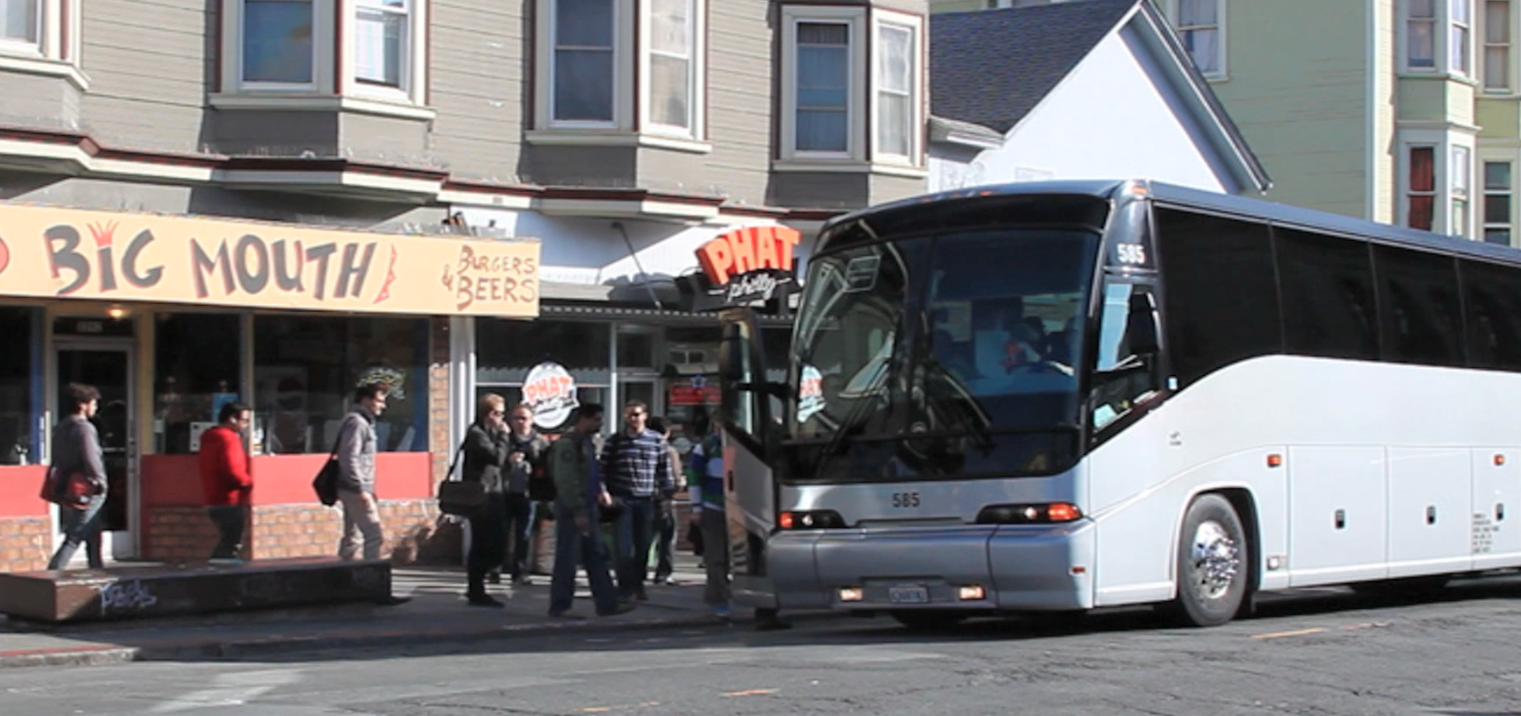Sustainabilities: Eco-oriented | Market-oriented | Vernacular

An Apple Bus stops on 24th Street in the Mission, photo: Kristin Miller
Young digital “creatives ” have been moving to San Francisco in droves since the original dot-com boom of the late ’90s. Since 2006, this has been accelerated by the so-called “Google Bus,” private buses that connect desirably “urban” Bay Area neighborhoods with the suburban campuses of Apple, Facebook, Google, Yahoo! and others. Today, the private buses carry tens of thousands on a daily basis, siphoning riders from the region’s transit systems and causing public outcry.
The displacement brought about by this influx of new arrivals is nowhere more fraught than in the Mission, previously a lower-rent neighborhood that provided an accessible home for generations of San Francisco’s immigrant communities—first Irish, German, and Polish, then, starting in the 1940s, Mexican and Central American. While it could be (and often is) argued that urban spaces are dynamic and constantly evolving, and that the Techies are just another wave of immigrants using the Mission to gain a foothold—residents who are being pushed out by rent—hikes and condo conversions they cannot afford are multi-generational families, small-business owners, teachers, first responders, artists, activists, and performers, and service workers of all kinds. They are also largely from communities of color. The more recent arrivals have demographics that match the tech industry’s—64% white and 74% male. They are also typically young, unmarried or child-free, and earn extravagant salaries: in 2012 the mean annual salary for a network specialist was $94,000.
By SFMTA estimates, in 2014 private buses within San Francisco provided some 35,000 “boardings” per day. In fact, Marty Lev, Google’s vice president of safety, security, and transportation, had said back in 2007, when the Google buses carried only 1,200 employees daily: “We are basically running a small municipal transit agency.” Debate now rages over the buses a pilot program instituted by the City that gives partner company's buses permission to stop near public transit stops for $3.55/per stop. Tech bus stops in San Francisco and Oakland have been hit by direct action protests. The argument over the buses and the change they represent often breaks down into pro- and anti-tech camps, with personal attacks against the culture of tech workers or protestors, as embodied in a piece of street theater where a protestor playing a techie belligerently told those blocking a Google bus to “get a better job,” or the all-too-real comments made by former AngelHack CEO Greg Gopman that San Francisco is “grotesque” and “overrun by…drug dealers, dropouts, and trash.” What’s really at stake is a failure of belief in the city as a commons—a system that supports existing residents and new arrivals by integrating them into the collective spaces and systems perhaps best represented by public transportation. That there are entire networks of free transit options available to only some of the city’s wealthiest residents cannot help but create tension, especially against a background of skyrocketing housing costs and a wave of no-fault evictions. As rising rents are a predictable outcome of some transit-oriented development and the addition of new transit networks, it is doubly problematic that these new transit options within the city are inaccessible to most of San Francisco's residents.
Google’s white Van Hool buses run from San Rafael in the north to Santa Cruz in the south and Danville in the east. While the battle of the buses has focused on San Francisco neighborhoods, and the mission in particular, the private transit network is an issue on a regional scale. Google’s routes represent only a fraction of the miles traveled by buses owned by Apple, Facebook, Electronic Arts, eBay, Yahoo!, Genentech, Box, Netflix, and countless other companies whose transport is subcontracted to Bauer’s IT. The tech companies, in their libertarian, do-it-yourself way, have solved the transit problem for themselves, not waiting for a potentially time-consuming, representative political process to do the job. They’ve put their workers on comfortable, Wi-Fi-equipped buses where they can work and conference during their commutes—a net gain in hours for their employers. Despite the vaunted ingenuity of Silicon Valley, however, the lack of coordination within this system results in multiple fleets of mammoth buses plying the same routes minutes apart and often traveling partly or mostly empty.
This begs the sustainability argument that Google and others have put forward as a key innovation and advantage of the buses. Tech companies and the regional governments that enable them claim the buses are "win-win"—relieving traffic, pollution, and further paving of Silicon Valley. But while the buses reduce corporate carbon emissions, they may well expand the regional footprint, as those underserved by drained public transit systems are more likely to commute by car. What’s more, as the downtown cores of Bay Area cities become unaffordable to everyone from civil servants to the many people who provide services for techies who work 60 to 80 hours a week, commuting times for non-tech workers may get longer. The likely result: more commuters sitting in traffic jams, because transferring from bus to Caltrain to BART to bus is a modal transfer or two too far—rendering the buses agents in a city-wide process of environmental gentrification.
– Kristin Miller
*Portions of this text first appeared in "Mapping our Disconnect" in Boom: A Journal of California.
Published June 1, 2015

